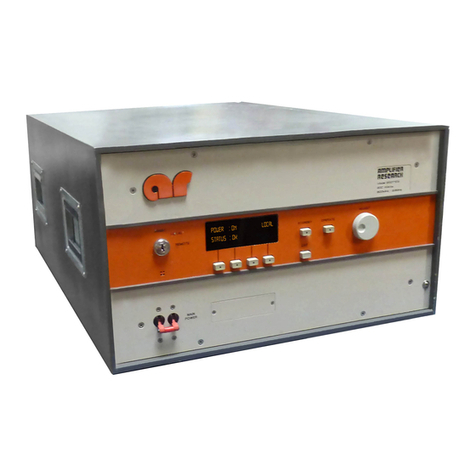
SPECIFICATIONS
Model 1000L
POWER OUTPUT
High Range
Pulse
Minimum ..................................................................2500 watts to 150MHz
1750 watts to 220MHz
Duty Cycle ................................................................15%
Pulse Width...............................................................8 milliseconds
CW
Minimum ..................................................................1200 watts
Low Range .......................................................................100 watts nominal
FLATNESS, high range................................................... ±± 1.5 dB
FREQUENCY RESPONSE..............................................10 kHz - 220 MHz instantaneously
INPUT FOR RATED OUTPUT .......................................1.0 milliwatt maximum
GAIN (at maximum setting)
High Range.............................................................61 dB minimum
Low Range..............................................................47 dB minimum
GAIN ADJUSTMENT (continuous range).......................18 dB minimum
INPUT IMPEDANCE......................................................50 ohms, VSWR 1.5:1 maximum
OUTPUT IMPEDANCE...................................................50 ohms, nominal
MISMATCH TOLERANCE* ........................................... 100% of rated power without foldback. Will
operate without damage, or oscillation with any
magnitude and phase of source and load
impedance.
MODULATION CAPABILITY ........................................Linear amplitude and phase response to over 80 MHz
allows faithful reproduction of AM, FM, Pulse, or phase
modulation appearing on the input signal
HARMONIC DISTORTION AT 750 WATTS
Above 120 MHz.......................................................Minus 30 dBc maximum
Below 120 MHz.......................................................Minus 15 dBc maximum
Minus 18 dBc nominal
THIRD ORDER INTERCEPT POINT.............................66dBm Typical
GATING CHARACTERISTICS
Pulse Mode Pedestal/CW Mode Blanking
Signal (into 180 ohms)........................................Plus or minus 2.5 to 6.0 VDC
Rise time.............................................................20 microseconds maximum
Fall time............................................................. 4 microseconds maximum
RF Rise/Fall Time...................................................10 nanoseconds maximum
RF Pulse Droop ......................................................1.0% maximum at 8 milliseconds
PRIMARY POWER (specify one).....................................200/208 ±± 5% VAC, 3 phase, 50/60 Hz
380/415 ±± 5% VAC, 3 phase, 50/60 Hz
400/415 ±5% VAC, 3 phase, 50/60Hz
15.2 kVA nominal
CONNECTORS
RF Input.................................................................Type BNC female
RF Output, high range............................................Type C female
RF Output, low range..............................................Type N female
Gating/Blanking .....................................................Type BNC female
Remote Control .......................................................25 pin female subminiature D
COOLING........................................................................Forced air (self contained fans)
WEIGHT..........................................................................239 kg (525 lb)
SIZE (WxHxD) ................................................................56.1 x 149.9 x 58.4 cm
22.1 x 59.0 x 23.0 in
* See Application Note #27

































